- Getting around Lijiang. Dont stay in the Old Towns more than 2 days, there is nothing to do. KRISS Oct 9, 2013 05:46
- 2013 Beijing Temple Fair BENNYLAU Feb 26, 2013 03:29
- Malaysian traveling from KUL - LAX vis Shanghai PVG ZATI_DY Jan 3, 2013 20:15
The End of the Wall
- Views: 5437
- |Vote: 0 0
- |Add to Favorites
- |Recommend to Friends
The other end of the Wall
Earlier in the year I had stood on the most easterly tip of the Great Wall at Lao Long Tou or Old Dragon Head. Today I would stand on a restored section of the most westerly extremity the Wall. Thousands of kilometres separated these points – one beside the sea and the other in the desert. The Wall once extended beyond this point but the crumbling Xuanbi Changcheng or Overhanging Great Wall believed to have been built in 1539 is now considered the most westerly extremity of the wall and was reconstructed in 1987. A steep climb to the highest tower reveals the inhospitable desert and steep, rugged mountains surrounding Jiayuguan, and on a clear day the snow capped peaks beyond.
With dust and smog in the air visibility was poor. From the Wall about 11kms from town the only thing we could see with any clarity was the sharp line between the dry dusty desert and the fertile farmlands fanning out beyond the outskirts of the city. The temperature soared as we climbed the wall passing a French couple on their way up. Mum stopped and chatted with a Chinese woman taking respite from the scorching sun in a patch of shade offered in a bend of the wall. They both waited for their daughters – hers was an English teacher from Shanghai - to return from the summit. It was cool up there in the breeze and shade of the tower and soldiers on watch must have been bitterly cold on winter nights.
With just a few hours sleep the night before and only a few hours to visit all the sites before catching an afternoon bus we hired our taxi driver to show us around for Y100. Great value for three of us. The road out to the wall passed through the dreary grey desert interspersed with incredibly clean and green villages. Each home was hidden behind a high and sturdy brick fence with colourful tile paintings on lintels over the gates. The neatly paved footpaths were flanked by shady trees, flowers and small crops. Not an inch of ground seemed wasted. Occasional large tents outside the gates aroused our attention – they were roadside cafes we discovered later.
‘Impregnable Defile under Heaven’
Named after the fort built in 1372 and affectionately called ‘Impregnable Defile under Heaven’ the city of Jiayuguan is surrounded by the unforgiving desert sands. The fort was originally built to defend the pass through the mountain range between the Black mountains in the north and Qilian peaks to the south. The ‘Gate of Enlightenment’ faces the east and the ‘Gate of Conciliation’ the west. Over each gate stands a 17m high tower overlooking the interior and exterior of the fort. On the inside of each gate a horse ramp leads up to the top of the fortified wall. If the enemy did manage to penetrate the huge outer gates they would be shot down by archers on the walls before they ever reached the inner gate.
Outside the ‘Gate of Conciliation’ – now the fort’s back gate – we found camels to ride for a small fee but there was something more interesting out here. While we got hustled by the camel drivers my mother had noticed a young Chinese man with a bicycle and had slipped aside to talk to him. She discovered he had taken several months off work and was nearing completion of an epic cycling trip from Shanghai on the coast to Kashgar in the mountainous west of Xinjiang. He was traveling very light with just one change of clothes and lots of drinking water, often sleeping out at night and planned to take the train back to Shanghai when he had reached his goal.
We were hungry after several hours walking around the wall and the fort when we dined on one of the local specialty dishes - Liang Mian or spicy cold noodle. We ate in a tent similar to those we had seen earlier, ordering three bowls but each generous meal could have fed two of us. The tent was equipped with comfortable lounge chairs, tables, stools and karaoke machines and while we ate, other guests played cards while they waited for their meals. It was refreshingly cool inside and the sides of the tent can be rolled right up to allow the breeze to flow through the lightweight interior mesh screens. Perfect in these hot conditions.
A new state of the art Museum recently opened on the site and is well worth the visit. On display are artefacts, weapons and building and construction methods and information relating to the building of the wall and the fort. The entrance to the Fort is set beside a stone forest park and gardens with a small zoo. Souvenir vendors sell a variety of items in the car park next to the ticket office. Out here the unpreserved weather-worn mud brick wall snakes its way across the desert from the fort disappearing into the distant haze.
Water in the Wei
Our last stop was the most visually interesting and just as historically significant. Jiayuguan, another oasis in the Hexi corridor of western Gansu was once considered the western boundary of the Empire. During the early Ming Dynasty around 1372 it was of vital importance as a military post on the Wei River. Without water, life in the desert would be difficult if not impossible but for centuries the Wei has carried snow melt from the northern mountains carving a deep precipitous gorge through the desert bringing precious supplies of water to an otherwise dry land.
We drove out on the other side of the city to the Wei River Gorge where the road cuts through an unrestored section of mud - brick Wall. I could not resist stopping to take a photo standing on this remote piece of history. We pulled up in what seem to be the middle of no where and our driver escorted us to the entrance of a tunnel which led to a underground cavern housing a viewing deck above the river, a dinosaur skeleton imbedded in one wall, a kiosk and a flying fox across the river. The water flows swift and shallow and is the same dun colour as the surrounding desert. Gravel is quarried from the exposed sandbanks in the river bed.
While my mother accompanied the driver to wait in the car park above the replica of an isolated military outpost we took the ‘fox’. It truly was a ‘flying’ trip across this awesome river and an exhilarating way to travel. We crossed back over the river on a beautiful suspension bridge. This museum included five dome shaped adobe buildings for officers - considerably cooler inside - soldier’s barracks, a prison, transport vehicles, weapons and a wide range of equipment for the purpose of torture. It seems that there was little room for hospitality in this inhospitable environment. It was a hot and steep climb up the sandy slope on a timber and chain walkway to the car park in the afternoon heat.
Lurching into Lanzhou
It was time we returned to catch our bus to Lanzhou. Arriving a little early we chose the three lower bunks in the front of the bus. Gansu would have to be one of the poorest provinces in China and again we would travel over some of the worst roads. A new road lay parallel to the old road for much of the way but was not yet open for traffic so we alternated between smooth and rough surfaces and narrow windy tree lined roads and broad smooth highway. The bus rattled and jumped, bumped and lurched, rolled and swayed, pitched and tossed over endless stretches of ‘highway’.
Each passenger is issued with a doona and it certainly was a welcome comfort as night fell. With no air-conditioning we drove with the doors and windows open only closing them when we encountered clouds of dust stirred up ahead of us. It was difficult to sleep despite being relatively comfortable. During the daylight hours we watched as we passed through small crop farmlands of corn, potatoes, garlic, onions, wheat and rice and small villages lining the road for much of the way.
Stopping frequently we seemed to pick up more passengers than we had beds for and there seemed to be some regulars – one a young student, Zhangmin returning to University in Lanzhou. I’m not sure where all the extra passengers slept but they always moved to the rear of the bus. Zhangmin translated for one of the drivers who was an avid coin collector and we were able to exchange some Australian notes and coins for him to add to his collection. As day dawned it was apparent that the scenery had changed little during the night but as we approached Lanzhou the barren hills closed in around us. They were a strange sight with horizontal contours from top to bottom like rice terraces with young trees holding on tenuously to life. This massive project to revegetate the hills will aid in reducing erosion, run-off and dust storms which plague most desert cities. From Lanzhou we would finally say goodbye to the deserts north western China.



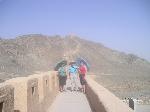
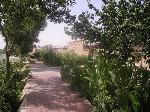
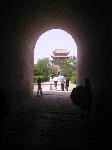

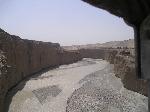
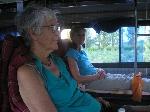
 Copyright © 1998-2025 All rights reserved.
Copyright © 1998-2025 All rights reserved.